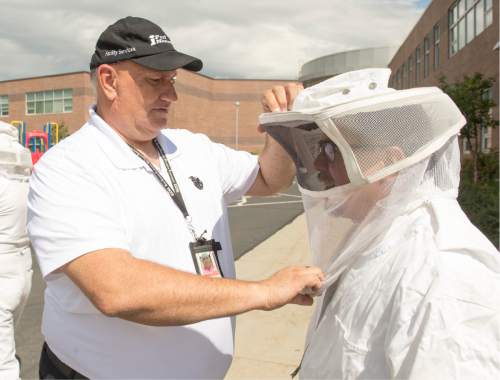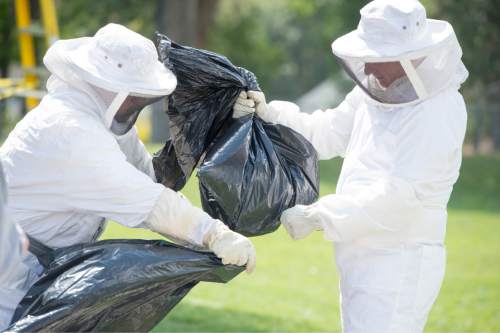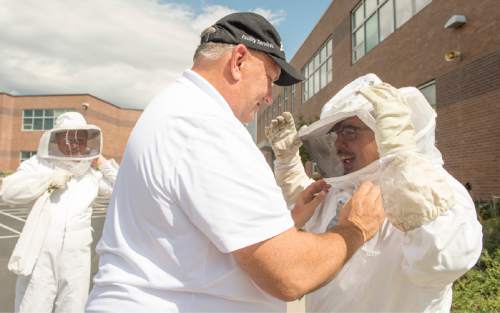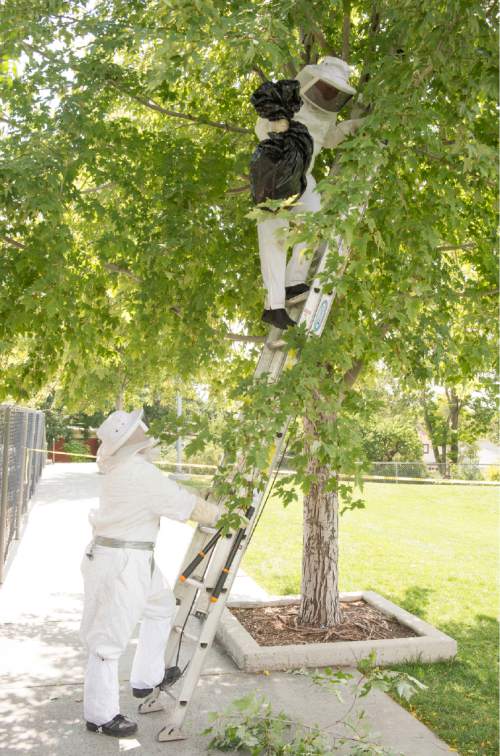This is an archived article that was published on sltrib.com in 2015, and information in the article may be outdated. It is provided only for personal research purposes and may not be reprinted.
Ricky Martinez stopped to adjust his protective suit before crossing a line of yellow caution tape at Beacon Heights Elementary School.
An assistant custodial supervisor for Salt Lake City School District, Martinez was preparing last week to bag a bald-faced hornets' nest in a tree a stone's throw from the school's playground.
His suit was crudely patched together by long strips of duct tape on the chest. But it was the zippers around his neck that concerned Martinez the most.
"They go for the face," he said. "They're smart."
In past years, Martinez and his team would have sprayed the nest with pesticide from a safe distance rather than physically handle a swarm of wasps.
But since 2005, Salt Lake City School District has used a pest-control practice known as integrated pest management that sees pesticide as a last resort.
"Pesticides are basically designed to kill or harm a living organism," said Ricardo Zubiate, the district's assistant director over facility services. "It has a purpose and that purpose is not a good one."
The district was the first in the state to launch an integrated pest management, but last year the Utah Department of Health required all schools to follow suit.
The idea is to think like a pest, Zubiate said, and remove entire nests — and the conditions that help them thrive — rather than expose children to harmful chemicals.
That means fixing leaky pipes, removing clutter and caulking gaps in walls and windows to make schools as hospitable to children, and inhospitable to pests, as possible.
"Children are more affected by pesticides than adults," Zubiate said, "because they're still developing."
Before implementing the program, Zubiate said, the Salt Lake City School District would fully fumigate every school on a monthly basis.
But during 10 years of integrated pest management, he said, pesticides have been used fewer than 45 times and only in targeted sprays.
"If you do the math on that," Zubiate said, "those are amazing numbers on the reduction of pesticides we've used."
The practice is also more effective, according to custodial manager Robin Anderson.
If the clutter or water leaks that attract pests aren't fixed, he said, critters will simply return after the fog of pesticides dissipates.
"When they did sprays and things in the past, it was only a Band-Aid," he said, "and they'd have to come back and do it every month."
Anderson said he had been stung three times while removing a wasps nest earlier this year. He said ants, bees and wasps are the most common schoolyard pest, but he's also come face to face with skunks, rats, raccoons, even bats.
The old way of doing things kept him at a safe distance, he said, but it didn't fully resolve the problems at schools.
"It's easier," he said, "but it's sometimes not as effective as doing it the right way, either."













